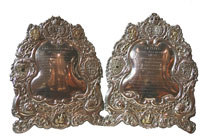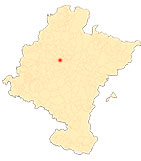Treasure of San Fermín
By Ignacio Miguéliz Valcarlos
Sacred
Set of two vertically projecting, rectangular profile sacral panels with a trimmed, mixtilinear outline, standing on two legs in the form of a vegetal scroll. They are articulated by means of a large central mixtilinear cartouche filleted by a thick convex moulding composed of opposing scrolls, where the corresponding liturgical texts are incised: Lavabo and Last Gospel. Both pieces have an exuberant decoration articulated by means of simple and fan-shaped rocailles and vegetal elements that completely cover their borders and frame the central field with the inscriptions. This decoration is complemented by a rich iconography, arranged in winding cartouches, joined together by an openwork, superimposed chain, alluding to the heraldic arms of Navarre, parallel to profile of the field. Thus, at the top are San Fermín and San Francisco Javier, co-patron saints of Navarre, framing the emblem of the Five Wounds, adopted by the Pamplona regiment in 1599. At average the coats of arms of Pamplona and Navarre, with the figure of San Saturnino in the centre of the lower part. Both the plaques of San Fermín and San Francisco Javier, as well as the figure of San Saturnino and the chains that make up the coats of arms of the capital and the kingdom, as well as the chain that joins these cartouches, are made of gilded silver, thus seeking an effect of plastic richness based on the chromatic contrasts between the gilded silver and its colour, which is complemented by the green glass that replaces the emerald of the arms of Navarre. All this in works with broken, sinuous profiles, which give them a restrained movement.
Both pieces are stamped with the double mark required in Pamplona, the locality mark, a double crowned P, the stamp of the capital of Navarre, and the maker's mark, YAVAR, corresponding to one of the marks used by the Pamplona silversmith José de Yabar (1713-1777), son of the master silversmith Hernando de Yabar (1671-1725), with whom he first trained, later completing his apprenticeship in the workshop of the Zaragozan silversmith José de Godoy, where he stayed for six years. This silversmith obtained his master silversmith's Degree in 1728, with the design of a holy water font, beautifully designed design, very correctly drawn and profusely decorated with plant motifs. He used two different types of mark staff, apparently indistinctly, without one replacing the other over time, on the one hand a head with helmet, and on the other his surname arranged in a single line and in capital letters, just as it is stamped on the holy water fonts studied here. Numerous works by José de Yavar have survived to the present day, all of them religious, with the exception of a cupbearer in a private collection. These sacras were commissioned by Pamplona City Council, patron saint of the chapel of San Fermín, and were delivered in 1774 by the silversmith Pedro Antonio de Sasa, who, married to a niece of Yabar's since 1772, shared the workshop with the master. The cost of the sacras was one thousand two hundred and ninety-four reals and thirteen maravedíes, which also included the cost of the workmanship of the pieces and sixty-seven ounces of silver used in their execution. The complete set has not been preserved, as the central piece, which is usually larger than the side pieces, is missing.
-
ANDUEZA UNANUA, P., La arquitectura señorial de Pamplona en el siglo XVIII. Familia, urbanismo y ciudad, Pamplona, Government of Navarre, 2004.
-
ARBETETA MIRA, L., "Cadena y cruz pectoral del tesoro de San Fermín", in ARRAIZA FRAUCA, J., San Fermín patrono, Pamplona, Pamplona City Council, 1989.
-
ARRAIZA FRAUCA, J., San Fermín. El santo, la devoción, la fiesta, Pamplona, Pamplona City Council, 2002.
-
GARCÍA GAINZA, M. C., and others, Catalog Monumental de Navarra. V***. Merindad de Pamplona, Pamplona, Government of Navarre-Archbishopric of Pamplona-University of Navarre, 1997.
-
HEREDIA MORENO, M.C., "Ejemplos de mecenazgo indiano en la capilla de San Fermín de Pamplona", in yearbook de programs of study Americanos, Tomo XLVI, 1989.
-
HEREDIA MORENO, M.C., "Bandejas y jarras del tesoro de San Fermín", in GARCÍA GAINZA, M.C., and FERNÁNDEZ GRACIA, R., (coords.), Juan de Goyeneche y el triunfo de los navarros en la monarquía hispánica del siglo XVIII, Pamplona, Fundación Caja Navarra, 2005.
-
HEREDIA MORENO, M. C., ORBE SIVATTE, M., and ORBE SIVATTE, A., Arte hispanoamericano en Navarra. Plata, pintura y escultura, Pamplona, Government of Navarre, 1992.
-
MIGUÉLIZ VALCARLOS, I., "El tesoro de San Fermín: Donación de alhajas al Santo a lo largo del siglo XVIII", in Promoción y Mecenazgo del Arte en Navarra. Cuadernos de la Chair de Patrimonio y Arte Navarro, nº 2, Pamplona, Chair de Patrimonio y Arte Navarro, 2007.
-
MIGUÉLIZ VALCARLOS, I., "Sacras con los patronos de Navarra y Pamplona", in FERNÁNDEZ GRACIA, R. (coord.), Pamplona y San Cernín 1611-2011. IV Centenary of the city's vow, Pamplona, 2011.
-
MOLINS MUGUETA, J.L., Capilla de San Fermín en la iglesia de San Lorenzo de Pamplona, Pamplona, Diputación Foral de Navarra, 1974.
-
MOLINS MUGUETA, J.L., "La mitra y báculo dieciochescos de San Fermín", in Diario de Navarra. Extraordinary of San Fermín, Pamplona, 1984.
-
MOLINS MUGUETA, J.L., "Mitra y báculo de San Fermín", in MORALES, A. J., Filipinas, puerta de Oriente: de Legazpi a Malaspina, Barcelona, SEACEX, 2003.
-
MOLINS MUGUETA, J.L., "Mitra y báculo del tesoro de San Fermín", in GARCÍA GAINZA, M. C., and FERNÁNDEZ GRACIA, R., (coords.), Juan de Goyeneche y el triunfo de los navarros en la monarquía hispánica del siglo XVIII, Pamplona, Fundación Caja Navarra, 2005.
-
ORBE SIVATTE, A., Platería del reino de Navarra en el siglo del Renacimiento, Pamplona, Government of Navarre, 2000.
-
ORBE SIVATTE, M., Platería en el taller de Pamplona en los siglos del barroco, Pamplona, Government of Navarre, 2008.












